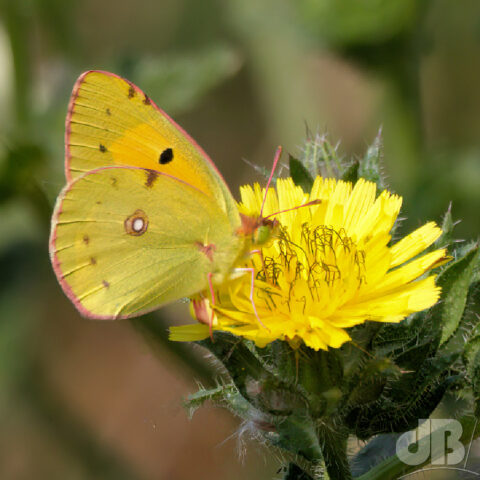In the summer of 2020, just after the first covid lockdown, I visited Waresley Wood, which is a few miles west of the city of Cambridge. The wood itself is good for Silver-washed Fritillary and the adjacent Brown’s Piece has plenty of Marbled White. That summer, there was a small patch of meadowland next to a maize crop where Common Blue and Brown Argus danced among clover, borage, viper’s bugloss and vetch.

On that visit, I also spotted a couple of fast-moving and vivid butterflies chasing up and down this ad hoc meadow. They were Clouded Yellow butterflies, Colias croceus. The species is quite rare in the British Isles and if you see one here it will usually be a migrant that’s flown in on an Easterly breeze from continental Europe. Some years we do get irruptions, mass immigrations, where they arrive in relatively large numbers in the summer and breed.

As to why they are so fast moving compared to some other related species, such as the “cabbage” whites, the Clouded Yellow does not accumulate toxins from the plants it eats. Where the Whites are often unpalatable to predators, such as birds, the Clouded Yellow is a tasty little morsel. However, while the more sedate Whites have poisons on their side to protect them, the Clouded Yellow has speed. It rarely sits still for more than a fleeting moment, as my good friend and fellow amateur wildlife photographer, Andy Hoy will attest. In between those rare rests it moves seemingly erratically and at speeds much greater than any White, or indeed any of the other butterflies you might see sharing the nectar of a wildflower meadow.
The Clouded Yellow will favour clovers growing on unimproved chalk downland, so that’s kind of terrain is a good place to look for them, especially in a “Clouded Yellow Year”. At the time of writing, Andy had spotted a solitary Clouded Yellow on a local reserve, without much forethought we shared a hike in a neighbouring patch and took a detour towards the end of the walk in the hope of catching sight of a few butterflies. We were expecting Common Blue, Brown Argus, European Peacock, Gatekeeper, Meadow Brown, and the aforementioned Whites, Large and Small, and were duly rewarded.
The hope of a Clouded Yellow or two was rewarded as we walked a 60×250 metre patch of wildflower meadow with plenty of clover, vetches, ragwort, sow thistle and other nectar-rich flowers on the edge of a wheat field. Glass half-full, I reckon we saw a couple of dozen Clouded Yellow, whereas Andy reckons it was perhaps a dozen. It could be that some of the same individuals were counted more than once. I asked the County Butterfly Recorder, Edward Pollard, for his opinion on this point, following his advice and being a little more half-empty than my I’d like to be, I’ll record perhaps 15 or so individuals but with a margin of error of about 5 or 6.